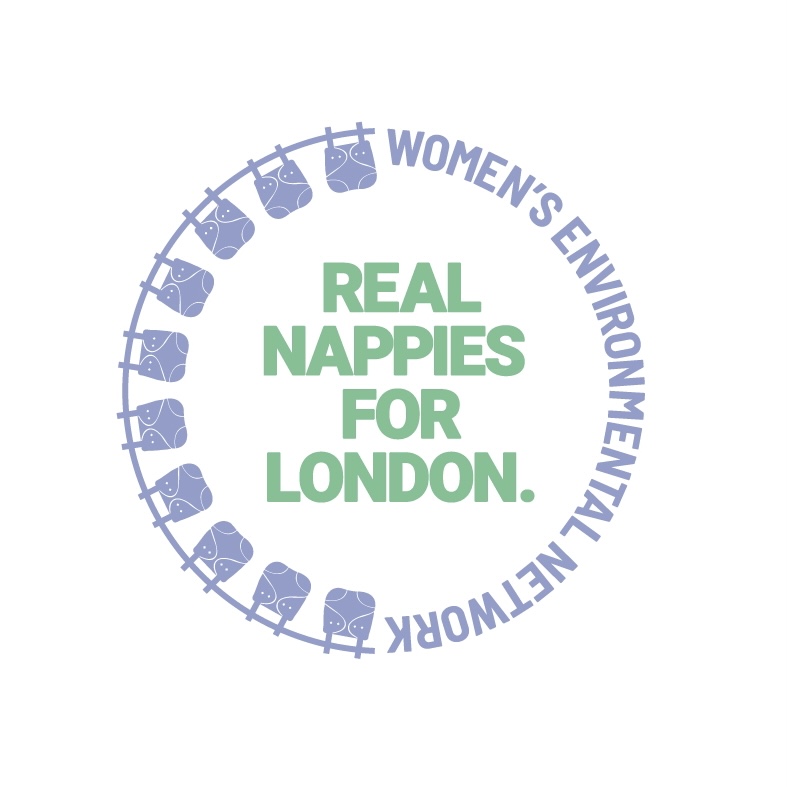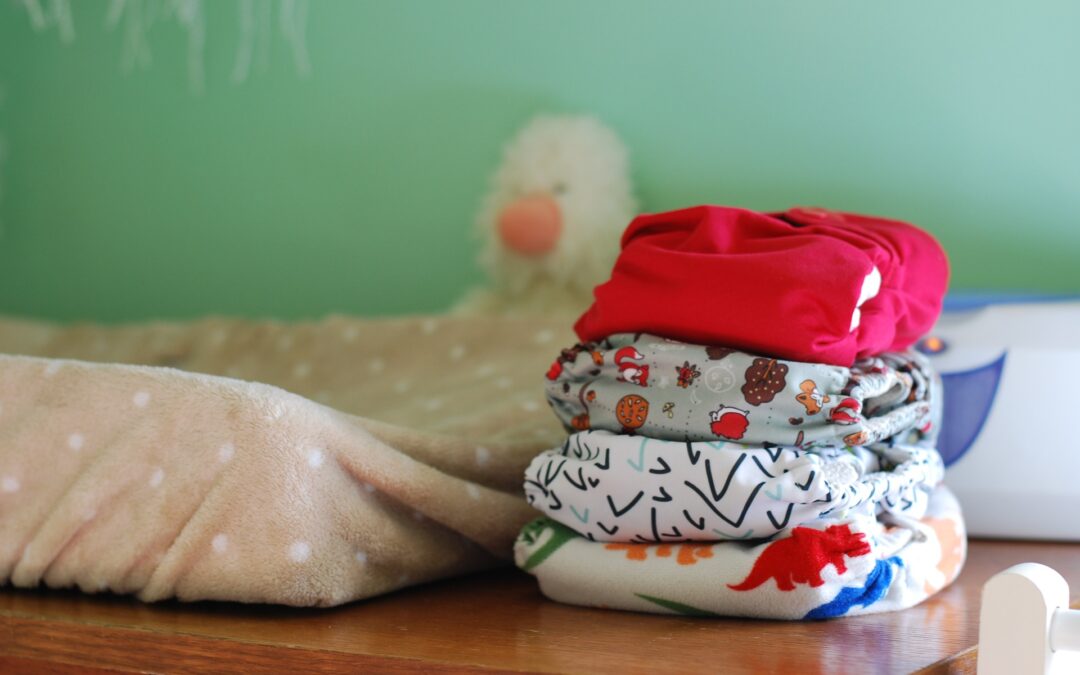There are many myths surrounding the world of reusable nappies. Often these myths can deter parents from using reusable nappies altogether. But this does not need to be the case. Here we bust eight common reusable nappy myths helping you become more informed:
Myth – reusable nappies smell
Parents worry about reusable nappies smelling of urine, or generally stinking, all the time. The truth is that this rarely happens if the nappies are cared for and washed properly. Tips below:
- Dry pailing – storing wet and soiled nappies before wash day in a bucket with a lid, or a waterproof wet bag, without water.
- Use a simple non-bio powder detergent and practice the powder-nappy ratio. The golden rule is that your nappies should come out of the washing machine smelling of nothing. If they smell of detergent, you have used too much; too little and they may smell of wee. Keep practising and you will get the right ratio.
Myth – reusable nappies are yucky
Reusable nappies seem to be associated with the “yuck factor” of poo more than disposable nappies. When in fact it is very far from the case for the following reasons:
- Newborn poo, which is runny from breastmilk or formula milk, is water soluble. This means that the washing machine cleans the nappies perfectly fine without causing blockages. It is not necessary to rinse or soak nappies before they go into the washing machine, making the washing factor far simpler and not at all yucky.
- Once your baby is older and is weaned on solids, their poo becomes more solid. If it is a soiled nappy, all you need to do is shake off any solids into the toilet, so the nappies are only wet when they are stored in your bucket/wet bag before washing. There should not be any solid poo in the washing machine.
- Liners can be placed in reusable nappies to catch weaned solid poo and to protect the nappy from staining. You can buy disposable paper liners which are thrown in the bin once the poo is tipped into the toilet, or you can buy reusable fleece liners that go in the wash with your nappies.
Surely, it is better to be disposing solids where they’re supposed to go (in the toilet), rather than having a stinking waste bin full of disposable nappies on a fortnightly waste collection? Regardless of whichever nappy system you’re using – disposable or reusable – dealing with your baby’s poo is a part of being a parent.
Myth – reusable nappies are expensive
People believe reusable nappies are more expensive because of the upfront cost, but in reality, the average weekly cost can be lower than disposable nappies (including weekly cost of washing):
| Standard Disposable Nappies | Reusable Nappies (depends on type of nappy) | |
| Weekly cost | £4.94 | £2.82 – £4.15 |
| Cost over 2.5 years | £642 | £367 – £539 |
On average, parents can make a saving of £488 over 2.5 years when switching to reusable nappies. There are also other ways to keep the up-front cost down further:
- Buy as you go instead of in one go – that way you can see what works well for your baby and buy more when you need more.
- Pick a cheaper type of reusable nappy – brand new all-in-one reusable nappies can cost on average £15 each, whereas flat nappies can cost on average £2 each.
- Consider preloved nappies – when cared for properly, reusable nappies can be used on your own subsequent children and/or passed onto other families with babies for free or bought at lower cost.
- Apply for a Real Nappies for London voucher. If you live in the London Borough of Bexley, Camden, Enfield, Hackney, Haringey, Islington, Lambeth or Waltham Forest with a baby under 18 months, or you are a parent-to-be, you are eligible to claim for a free reusable nappy voucher which can help with the initial cost to buying reusable nappies or for a trial washable nappy laundry service.
Myth – reusable nappies are not as absorbent as disposable nappies
There are four main materials used in the manufacturing of reusable nappies – hemp, bamboo, cotton, and microfibre. Hemp and bamboo are the most absorbent materials whereas a nappy made of microfibre may not be as absorbent but does dry the quickest. If you find that your baby’s reusable nappy is leaking or not lasting as long as a disposable nappy would, here are some thoughts to consider:
- Is it a fit problem rather than an absorbency problem? If the absorbent part isn’t properly fitted inside the waterproof part, or if the fit is too loose around the legs and back, then this may cause leaks.
- Is your baby a heavy wetter? The great thing about reusable nappies is that you can add boosters to increase the absorbency. Boosters are made from natural absorbent materials like hemp and bamboo.
- Disposable nappies only last so long because they contain sodium polyacrylate, a chemical used to absorb moisture. With reusable nappies, you are in complete control of what is against your baby’s skin, the absorbency of the nappy and its fit.
Myth – reusable nappies cause nappy rash more than disposable nappies
Nappy rash is a term that parents use to describe any kind of redness on their baby’s bottom. The cause of the redness could be many things other than nappy rash. Nappy rash is a rash that occurs when poo reacts with ammonia (stale urine). Research conducted at Bristol University strongly argues that reusable nappies are no more likely to cause nappy rash than disposable nappies.
If your baby’s bottom does look irritated, you should ask yourself the following questions:
- Are you changing your baby/cleaning your baby’s nappy area frequently enough? Whether your baby is in a reusable or disposable nappy, they should be changed frequently and their whole nappy area cleaned thoroughly in order to avoid nappy rash. They should especially be changed as soon as they have pooed.
- Are you washing your nappies properly? Sometimes irritation can occur when reusable nappies have a build-up of ammonia or detergent, caused by not being properly washed.
- Is your baby a newborn? Newborn babies have particularly sensitive skin, so we always advise to wash at 60 degrees until up to when they’re six months old.
- Placing a fleece liner inside the nappy (if it doesn’t already have a fleece layer) will make your baby feel comfortable and dry.
Myth – reusable nappies take a lot of effort to wash
There are a lot of myths saying that reusable nappies take up a lot of time and they constantly need to be soaked or rinsed to make sure they are cleaned properly. Modern reusable nappy designs, improvements in washing machines and a simple washing routine is all that’s needed:
- Storing dirty nappies – dirty nappies should be stored in a bucket/wet bag without water until wash day. Any solids should be shaken off the nappy, or liner, into the toilet – a simple rinse using the water from the toilet flush, or spray, can help remove the solids. Do not flush disposable liners.
- Washing – Reusable nappies should be washed every two to three days. All they require is a cold rinse wash and then a temperature wash. Note: nappies should be washed at 60 degrees if your baby is under 6 months. After that you can wash the nappies at 40 degrees.
- Non-bio powder detergent – supermarket own brand or branded (whatever you are using already) – is all you need to wash reusable nappies. You do not need to add detergent at the cold rinse stage, only on the temperature wash. You can opt to use nappy sanitisers, but these are not compulsory, so you don’t have to spend a lot of money on washing.
- Drying – Line dry where possible, away from direct heat like radiators as this can damage the material of some reusable nappies. Some manufacturers do say that you can tumble dry on low heat but remember, constant tumble drying can damage fibres over time and use more energy. Sun is the best, even a sunny windowsill.
Note: it is always recommended to follow the manufacturer washing guidelines and product care label.
Myth – they’re not that great for the environment
Some people have claimed that reusable nappies are not that much better for the environment than disposable nappies, using the consumption of land and water as their reason. Here are the facts provided by the most recent studies on the environmental cost of single-use products, including disposable nappies:
- It is believed that reusable nappies consume a huge amount of water due to the constant washing routine. However, it has been recorded by the Women’s Environment Network (WEN) that the manufacturing of wood pulp for disposable nappies is highly water-intensive It requires 230% more water to manufacture 2.5 years’ worth of disposable nappies than to wash 2.5 years’ worth of reusable nappies.
- The waste factor of disposable nappies is also important – it can take around 500 years for one disposable nappy to decompose in landfill. 8 million nappies are thrown into landfill or incinerated in the UK every day.
- By contrast, a reusable nappy can make carbon savings of up to 40% and can last through multiple children for several years. Once they can no longer be used they can be put in a fabric recycling bank or used for other purposes (check our Plastic Question blog for more details).
Myth – reusable nappies are not practical when out and about
Reusable nappies are very easy to use on a day out. You only need one addition to your changing bag: a wet bag. When you are changing your baby out and about, the only difference is putting a used nappy in a wet bag, instead of throwing it away in the bin.
At Real Nappies for London, we’ve supported over 12,000 London parents successfully make the switch to reusable nappies and they’ve enjoyed it too. We understand the concerns parents may have to something different. There is a long-standing throw away culture with disposable nappies. The truth is, reusable nappies are an amazing nappy solution that is: 1. Completely easy to use; 2. Reduces your waste; 3. Saves you money; 4. Is gentle on your baby’s skin, and 5. makes your baby look cool.
Go at your own pace. Establish your own routine. Debunk the reusable nappy myths.
June 2020
Jenny Weeks and Alice Walker

